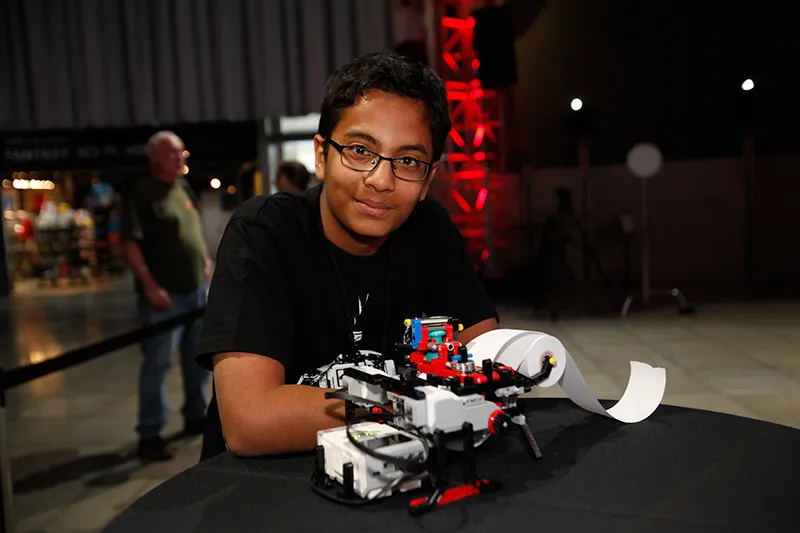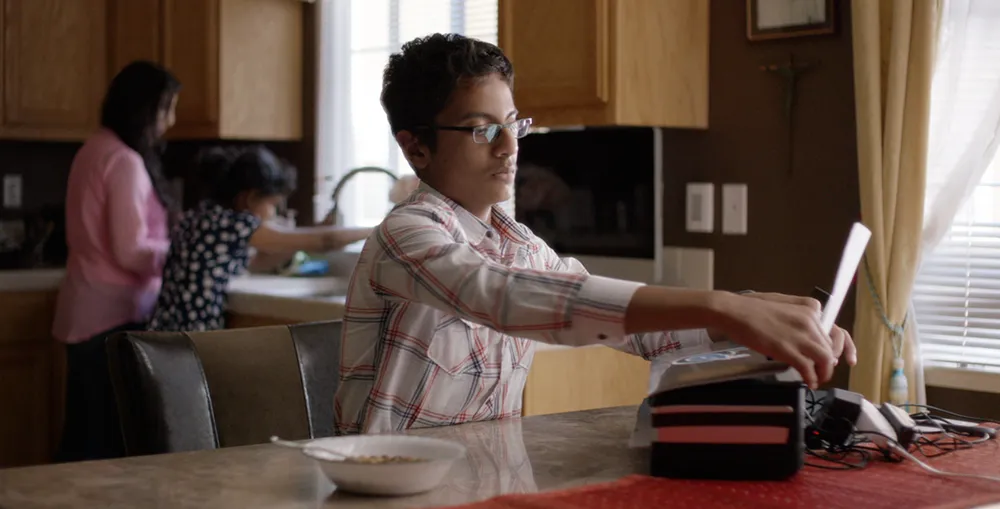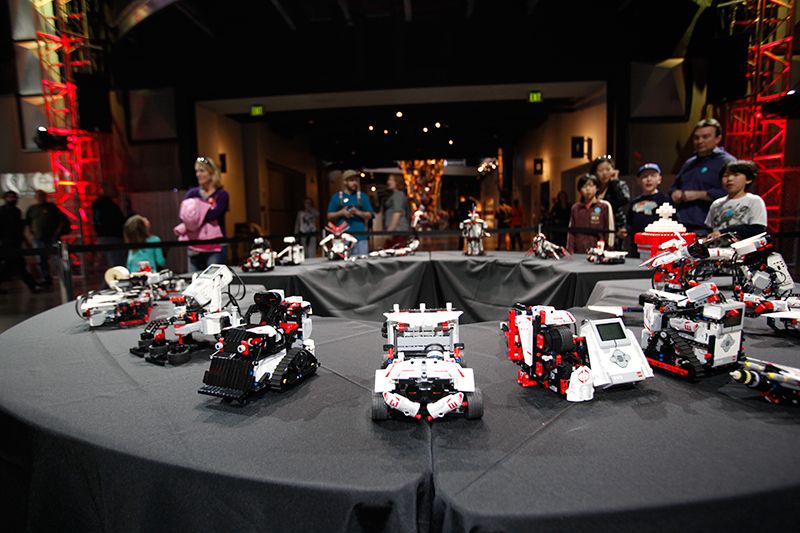Meet the 13-Year-Old Who Invented a Low-Cost Braille Printer
One California teen has a vision to make Braille materials more widely available—and more affordable
/https://tf-cmsv2-smithsonianmag-media.s3.amazonaws.com/filer/a0/2b/a02ba3bd-402b-445e-8747-b03260c0fbd1/shubham-banerjee.jpg)
According to the National Federation of the Blind, fewer than 10 percent of 1.3 million blind Americans can read Braille. By comparison, in the 1950s, more than half of blind children learned to read the series of raised bumps.
This change has been brought on, in part, by the growth in assistive technology. In the past decade, voice-to-text software has dramatically changed the lives of the visually impaired. There are software programs that read text aloud, and most consumer hardware devices such as smartphones and tablets come equipped with software that can answer questions or provide small bits of information. A surprisingly few people with low vision or blindness even have access to Braille materials.
Shubham Banerjee stumbled across these facts, just as he was trying to come up with an entry-level engineering project in January 2014 for a science fair.
The 12-year-old realized that while many people have devices able to read aloud in some capacity, assuming voice-to-text should replace Braille is a costly proposition and one many people simply can’t afford. What if he could significantly reduce the cost of a Braille printer from $2,000—the going rate for a traditional Braille printer-embosser—to $200? Some Silicon Valley startups had been trying to do the same but with little success.
It took several weeks and a number of attempts—seven, to be exact—before Banerjee built a working prototype, using a Lego Mindstorms EV3 robotics kit and some small electrical components that cost a few dollars, that printed the six dots of the Braille sequence. He’d often stay up until 2 a.m., toiling away on the device, his father Niloy, a software engineer, right there beside him at the kitchen table. Shubham notes that because his encouraging parents are always happy to purchase educational toys, it wasn’t hard to convince them to shell out $350 for a Mindstorms kit.

Now 13 years old and a Santa Clara, California high school freshman, Banerjee is the inventor of Braigo, a groundbreaking low-cost Braille printer-embosser. The Braigo printer is a small, portable machine that looks a lot like any other printer—only it spits out strings of raised bumps instead of flat text on a page.
Banerjee co-founded a small company, Braigo Labs, to help further develop the printer for educational and home use, as well as provide open source documentation to anyone who wants to buy the Mindstorms kit and try making a Braigo v1.0 at home. (“Braigo” is a portmanteau of “Braille” and “Lego.”) Braigo v2.0, an assembled off-the-shelf version, will hit the market this fall.
“Some [people] said that the market is not that big, or [that this is] a specialty product,” Banerjee says, unfazed. “I just went ahead with what I thought was right.”
The young inventor will be participating in the Smithsonian's Innovation Festival at the National Museum of American History on September 26 and 27. The two-day festival, a collaboration between the Smithsonian Institution and the U.S. Patent and Trademark Office, will look at how today's inventors—independent, and from companies, universities and government agencies—are shaping the future.
Will Butler, the media and communications officer for San Francisco non-profit LightHouse for the Blind, says that Braille isn’t in the same category as a dying language. “[Braille] doesn't die off or become irrelevant over time. It's simply code,” he explains. “And it's the only code that allows blind people to fully comprehend concepts like punctuation, homophones and other grammatical details note-for-note the way a sighted person could. For that reason, Braille is essential to literacy, particularly for those who have been blind from a young age.”
Henry Wedler, a PhD candidate in organic chemistry at the University of California, Davis, was extremely impressed when he read about Banerjee’s invention in the news. Wedler, who was born blind and has been honored by President Barack Obama as a Champion of Change for his work leading a chemistry camp for visually impaired students, took a chance and reached out to Banerjee. Several weeks later, Banerjee and his father took the printer to the university to demonstrate the device for Wedler in person.
“What I witnessed was a state-of-the-art, inexpensive and—perhaps most importantly—unique Braille printer that produced accurate Braille characters,” says Wedler, who is now an advisor to Braigo Labs. “Inventors have been attempting to do what Shubham has done with Braille embossers for many years. Sometimes, it takes a young, fresh imagination and a will of iron to be truly innovative. This is the energy and quality that Shubham’s knowledge and passion as an inventor bring to Silicon Valley.”
Butler adds that a low-cost Braille printer could be a game-changer for the blind, as physical aids, software and Braille materials can be expensive, and rehabilitation funding offered by the state is often only available for blind people who can show that they are working on specific job placement. “That’s a narrow slice of the population, even more so in the blind community,” he adds. “So for everybody else who can't qualify for state aid, any technology costs come out of pocket.”

Banerjee entered his new product in the 2014 Synopsis Science Fair, a countywide science fair for students attending schools in Santa Clara County, California; and took home the Synopsis Outreach Foundation n+1 Prize, the top prize for a science or engineering breakthrough. The Braigo printer, which won Banerjee a $500 prize, was up against engineering projects including radar-guided rock layer surface mapping and walking shoes that generate electricity.
Braigo Labs has filed four patents so far, and there will be more to follow, says Niloy Banerjee, Shubham’s father and director of Braigo’s board. The names Braigo and Braigo Labs have also been trademarked.

The young inventor even brought in venture capital to ensure the success of his creation. Intel Capital, the VC arm of the technology giant, awarded Braigo an undisclosed amount of funding—enough to hire engineers to keep working on the prototype. It also asked that Banerjee experiment with Intel’s Edison, a microprocessor roughly the size of an SD card that comes equipped with WiFi and Bluetooth. In September 2014, Banerjee showed off his latest prototype of the Braigo v2.0 at the Intel Developers Forum, an annual industry gathering of technologists, in San Francisco.
Banerjee doesn’t think of himself as a radical, world-changing inventor. “I just think of myself as a guy who wants to solve random problems,” he says humbly. Aside from a few jokes from his football teammates when they figured out they had a “genius” in their midst, Banerjee says his classmates don’t give his celebrity inventor status a second thought. “They’re pretty chill,” he adds, sounding unaffected by the attention. “They don’t treat me differently.”
That said, Banerjee does have plans for other projects. But for now, he says, those are secret.
Shubham Banerjee will be showing his Braigo printer at the Smithsonian's Innovation Festival at the National Museum of American History on September 26 and 27, between 10 a.m. and 5 p.m. The event, organized by the Smithsonian Institution and the U.S. Patent and Trademark Office, will feature examples of American ingenuity developed by independent inventors, academic institutions, corporations and government agencies.

